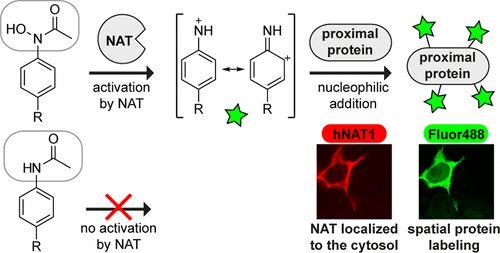当前位置:
X-MOL 学术
›
ACS Chem. Biol.
›
论文详情
Our official English website, www.x-mol.net, welcomes your feedback! (Note: you will need to create a separate account there.)
Subcellular Protein Labeling by a Spatially Restricted Arylamine N-Acetyltransferase.
ACS Chemical Biology ( IF 4 ) Pub Date : 2018-06-14 , DOI: 10.1021/acschembio.8b00178 Fleur Kleinpenning 1 , Selma Eising 1 , Tim Berkenbosch 1 , Veronica Garzero 1 , Judith M Schaart 1 , Kimberly M Bonger 1
ACS Chemical Biology ( IF 4 ) Pub Date : 2018-06-14 , DOI: 10.1021/acschembio.8b00178 Fleur Kleinpenning 1 , Selma Eising 1 , Tim Berkenbosch 1 , Veronica Garzero 1 , Judith M Schaart 1 , Kimberly M Bonger 1
Affiliation

|
Mapping proteins at a specific subcellular location is essential to gaining detailed insight on local protein dynamics. We have developed an enzymatic strategy to label proteins on a subcellular level using arylamine N-acetyltransferase (NAT). The NAT enzyme activates an arylhydroxamic acid functionality into a nitrenium ion that reacts fast, covalently, and under neutral conditions with nucleophilic residues of neighboring proteins. The electron density on the aromatic ring proved important for probe activation as strong labeling was only observed with an arylhydroxamic acid bearing an electron donating substituent. We further demonstrate that, using this electron rich arylhydroxamic acid, clear labeling was achieved on a subcellular level in living cells that were transfected with a genetically targeted NAT to the nucleus or the cytosol.
中文翻译:

通过空间受限的芳胺N-乙酰基转移酶进行亚细胞蛋白标记。
将蛋白质定位在特定的亚细胞位置对于获得对局部蛋白质动力学的详细了解至关重要。我们已经开发了一种酶促策略,可以使用芳基胺N-乙酰基转移酶(NAT)在亚细胞水平上标记蛋白质。NAT酶将芳基异羟肟酸官能团激活为亚硝酸根离子,该氮离子在中性条件下与邻近蛋白质的亲核残基快速共价反应。芳香环上的电子密度被证明对探针激活很重要,因为只有在带有给电子取代基的芳基异羟肟酸中才能观察到强标记。我们进一步证明,使用这种富含电子的芳基异羟肟酸,在被遗传靶向的NAT转染到细胞核或胞质溶胶的活细胞的亚细胞水平上实现了清晰的标记。
更新日期:2018-05-31
中文翻译:

通过空间受限的芳胺N-乙酰基转移酶进行亚细胞蛋白标记。
将蛋白质定位在特定的亚细胞位置对于获得对局部蛋白质动力学的详细了解至关重要。我们已经开发了一种酶促策略,可以使用芳基胺N-乙酰基转移酶(NAT)在亚细胞水平上标记蛋白质。NAT酶将芳基异羟肟酸官能团激活为亚硝酸根离子,该氮离子在中性条件下与邻近蛋白质的亲核残基快速共价反应。芳香环上的电子密度被证明对探针激活很重要,因为只有在带有给电子取代基的芳基异羟肟酸中才能观察到强标记。我们进一步证明,使用这种富含电子的芳基异羟肟酸,在被遗传靶向的NAT转染到细胞核或胞质溶胶的活细胞的亚细胞水平上实现了清晰的标记。



























 京公网安备 11010802027423号
京公网安备 11010802027423号